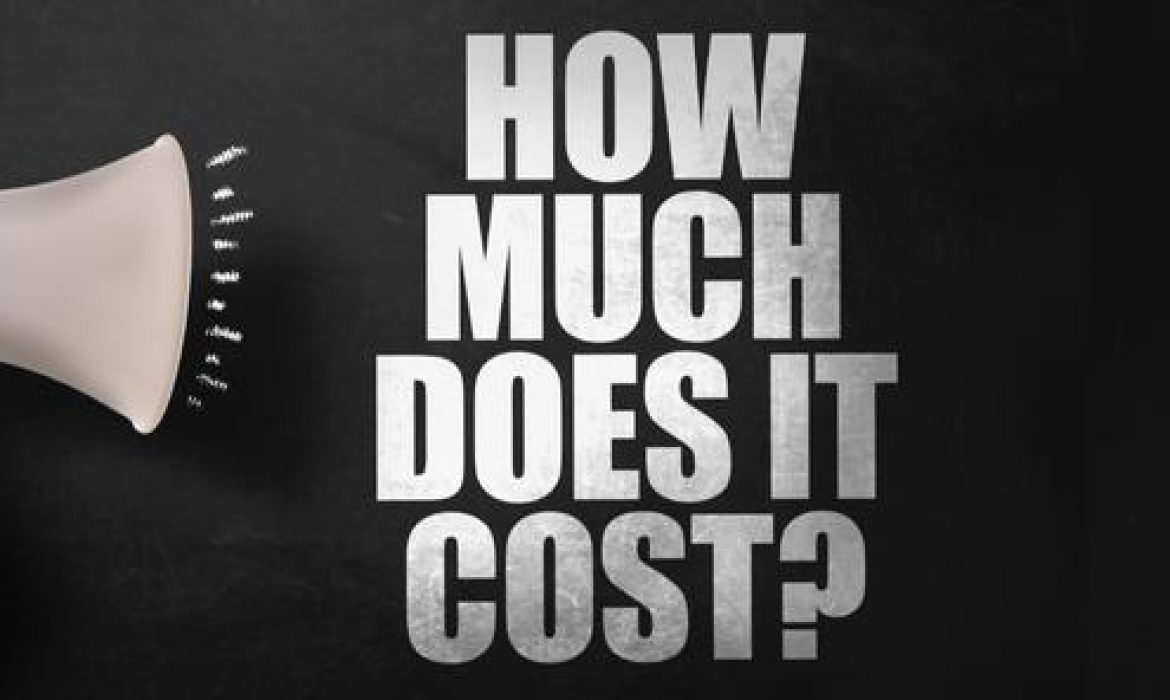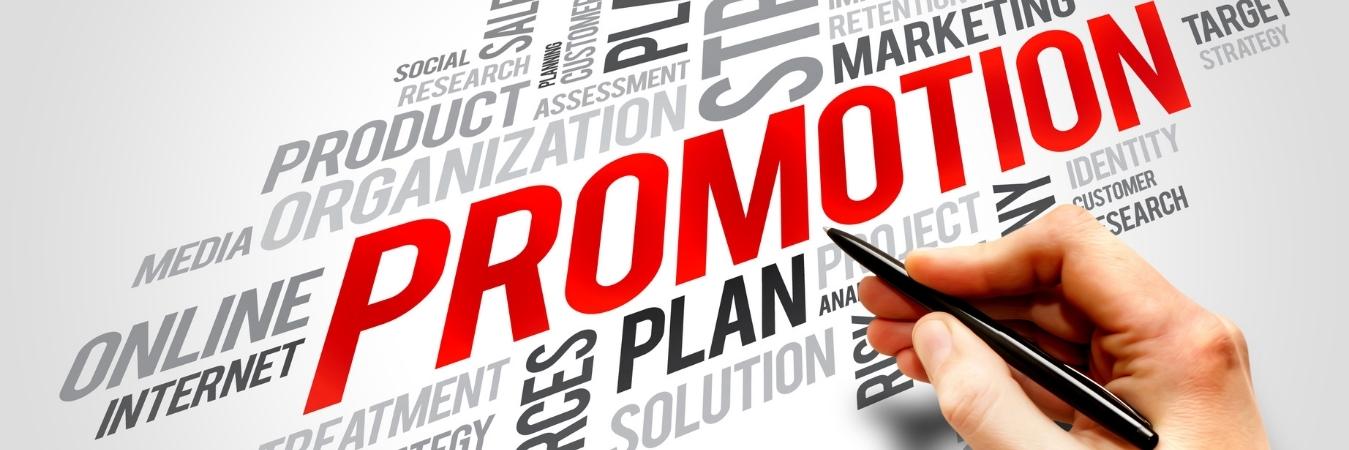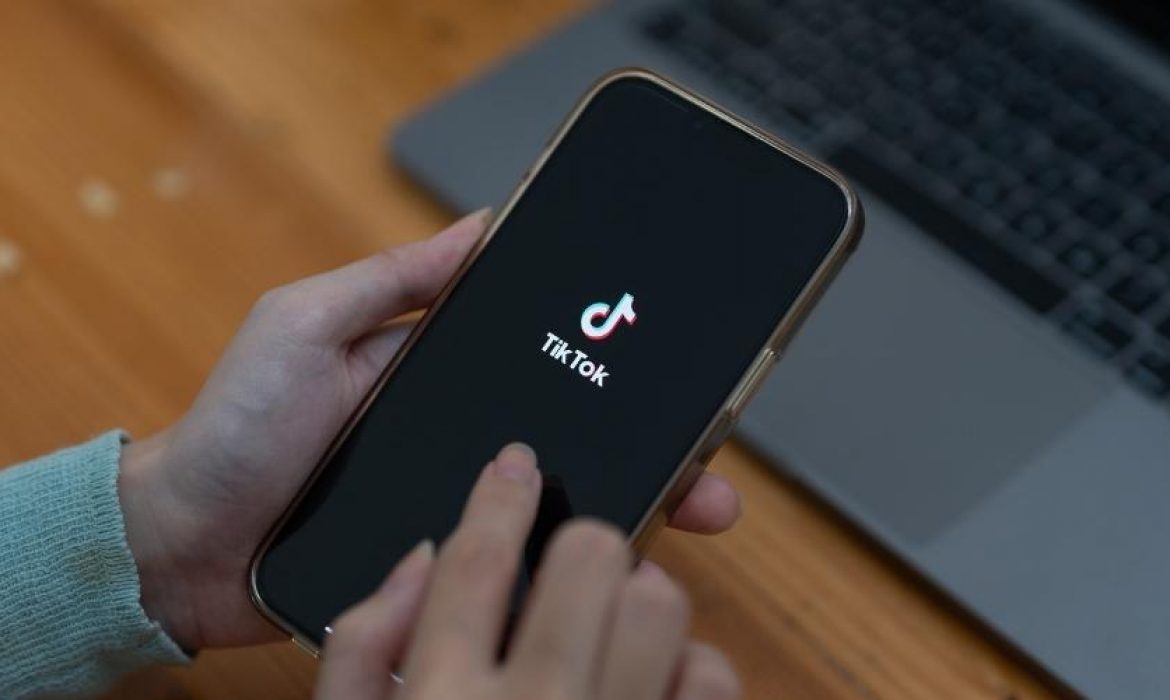How Much Does SEO Cost in Singapore?
If you’re searching for the best SEO Services in Singapore but don’t know how much it will cost you, the one-line answer is – it depends on which kind of service you get from the Company.
Especially in the B2B industries, SEO services in Singapore have always been in demand. Today 70% of marketers remark SEO as effective marketing compared to other campaign channels such as PPC.
What is SEO?
SEO (Search Engine Optimization) is essential for online business. It is a practice of appearing in top positions in SERPs for relevant searches. SEO is also necessary for all shapes and sizes of companies. It can be the best way to achieve your business marketing goals and get potential traffic and sales for your business.
SEO or search engine optimization is the process of getting traffic or exposure from search engine results pages (SERPs) in a free and organic way. With the help of SEO, you can promote your brand or business through various strategies, including keyword research and content curation, such as blogs or articles, videos, web page content, and more! Many business owners find it beneficial to rank their websites on SERPs’ first page or position. Therefore, the use of proper SEO techniques or strategies is essential. Furthermore, organic search is the most crucial means for everyone to find and access online content.
Therefore, an effective SEO strategy is very important for enhancing your website’s quality and quantity of traffic. It is also vital for the smooth running of significant sites. There are several techniques used to improve a website’s ranking, including
- Optimise titles and meta tags using relevant keywords and phrases
- Building quality backlinks
- Creating keyword-rich content
- Image optimisation
- URL optimisation
- More!
Additionally, SEO plays the most vital role in online marketing strategy. Therefore, you can boost your chances of driving traffic and generating leads by improving your website’s ranking.
Why Should You Use Effective SEO?
- Brand Awareness – A website with a high ranking attracts more visitors interested in learning about the business and its products.
- Your Competitors – Beat your competitors in organic search results might help boost the ranking position of your company/online business in your marketplace.
Here are Some of the Essential Benefits of SEO:
- Increase traffic
- Elevate your business to the next level
- Brand promotion and awareness
- Increased website usability
- High ROI
- Better conversion rates
- Beneficial for social media
Types of SEO
On-page SEO, Off-page SEO, and Technical SEO are the three types of SEO you require for a well-rounded organic search strategy to improve the website’s ranking position and traffic.
On-Page SEO:
On-page SEO, sometimes called On-site SEO, is optimising pages to improve a website’s rankings and enhance organic search traffic. With the help of on-page techniques, we can get visibility in search engines and increase traffic. The on-page strategy is structuring or building your website content to be user-friendly and search-engine-friendly.
Why is On-Site SEO Important?
For search engines to understand your website and its content and determine whether it is relevant to a searcher’s query, on-page SEO, also known as on-site SEO, is essential.
On-Page SEO Includes
- Meta Tags
- Content Optimization
- Image Optimization
- Keywords Optimization
- Internal Linking
- External Linking
- URL Structure
- Website Structure
- Heading Tags
- And More!
Off-Page SEO
It is also a method for improving your website ranking (SERPs). It also helps to boost the credibility, authority, and reliability of your website. Additional benefits of off-page SEO are increasing traffic, page and domain authority, and brand awareness. In simple terms, off-page SEO helps get quality backlinks from other sites.
Off-Page SEO Activities:
- Brand Mention
- Commenting
- Local Citation
- Video Submission
- Press Release
- Google My Business
- Forums
- Content Sharing
- Influencer Outreach
- Guest Posts
- Broken Link Building
- Social Network
- Social Bookmarking and
- More!
Technical SEO
In the whole process, technical SEO is an essential step. It is the pillar of improving a website’s speed, crawlability, and readability for search engines. Technical SEO is a part of on-page SEO, which is mostly concerned with improving elements such as optimization of site structure, website speed tests, and more! Its work affects search engine crawling and indexing either directly or indirectly.
By improving technical issues, you can help search engines to crawl and understand your website. If you succeed in doing this, search engines may reward you with higher rankings or even richer results.
Technical SEO Includes
- Page Elements
- XML Sitemaps
- Optimise Site Structure
- Redirects
- Optimise Robots.txt
- Optimise URL Structure
- HTTP Header Responses
- Fix Duplicate Content Issues
- Optimise Canonical URLs
- Website Speed
- Mobile Friendly Test
- Register your site with webmaster tools
- And More!
Best SEO Services & Pricing in Singapore for Businesses:
Many SEO companies provide basic SEO services or even preliminary services at the highest price. For this reason, many customers have suffered from financial loss without seeing any SEO results for their business.
Remember that SEO (Search Engine Optimization) plays an essential role in every digital marketing strategy and for all businesses and industries. It also helps with brand awareness, client acquisition, and overall business performance. That’s why we need to know how SEO charges work and the various package structures that an SEO company provides.
Below, we have listed some important factors that come into consideration when deciding the actual costs of SEO in Singapore:
1. Size and Type of Business:
See, the price you pay for SEO services will depend on the size & type of your business and the number of services you require. SEO pricing also varies from Company to Company, so it’s essential to remember that you get the best results when you pay for services when it comes to SEO. When choosing a good SEO Company, don’t compromise quality work for “low-grade SEO services. You should choose a top SEO company that offers top-quality SEO services in Singapore. Also, your goals should determine how much you should spend on services.
2. Competition Research:
This process can play a major factor in deciding the best SEO pricing in Singapore. Your competitors also have the same niche website and are vying for the top spot in the search engine result page (SERPs).
Whether your desired keywords have strong competition, improving your website position or getting the number one spot will require more effort and time. However, SEO companies might charge extra. Every SEO professional will begin work with competition research in your niche.
3. Industry:
Companies operating in a competitive industry often face hurdles when trying to rank for the same keywords on the website. Therefore, SEO experts must work hard to optimize everything to rank your website in your niche.
4. Services & Benefits:
All SEO Companies will not give you all the services, such as campaigns, content distribution, and more. That’s why the actual price will largely depend on the best-quality service of SEO and the benefits included in the campaign.
5. Time:
SEO companies usually provide the best results within approx. 3 to 5 months. They will require additional cost if you want results in a quicker timeline.
6. Guarantee:
Whether an SEO agency informs you that they can give you a guarantee to rank your website on the top position in the SERPs as it is not possible. It’s all probably a ploy to charge the high pricing for SEO services. Never forget that SEO organic results can never be 100% guaranteed. There are too many factors in search engine optimization (SEO).
Which SEO Pricing is Best for Your Business?
Most SEO companies in Singapore charge a fixed monthly fee that varies according to the work hours, requirements, and difficulty.
| Type | Starting Cost (Monthly, Approx) |
|---|---|
| Standard Level | $500-1300 |
| Mid Level | $700-1500 |
| Top Level | $1500-3000 |
| Avg. Hourly Rate | $50-$250 |
On the other hand, when it comes to the SEO pricing model, most SEO agencies in Singapore follow these SEO pricing packages that are including
- project-based,
- monthly retainer, or
- hourly consulting
Additionally, the SEO cost options you select typically depend on your budget, the amount of work required, and how flexible you want to be with your SEO work. Let’s talk about these four SEO pricing packages in detail below:
| Type | SEO Services | Average Cost, Approx. |
|---|---|---|
| Monthly SEO | SEO Audit Analytics Setup Routine Reporting Keyword Research Keyword Integration On-Page Optimizations Off-Page Optimizations Technical Optimizations Content Creation |
$1500 – $5,000 per month |
| SEO Consulting | SEO Audit SEO Recommendations SEO Implementation Routine Reporting |
$100-$300 per hour |
| Project-Based SEO | SEO Audit Project-Specific Optimizations Routine Reporting |
$5,000 – $30,000 per project |
Important note: Above, we have described just an estimate of SEO pricing in Singapore and the services included in the same package. However, it will vary from company to company and the type of service availed by the user.
Monthly Retainers:
With a monthly retainer, you pay the agency or freelancer a fixed amount per month, and they will handle all of your SEO needs regularly. That is why; it is one of the most common ongoing SEO pricing models.
Project-Based:
Project-based pricing models are similar to contract-based services. It allows customers to pay a set charge for custom SEO projects. In Singapore, approximately project-based SEO services can run you anywhere from $1,000 to $30,000.
Note: It is not an actual price of project-based pricing models; it’s just an estimated price.
Hourly Consulting:
You can pay agencies an hourly fee for SEO services in hourly consulting. Hourly SEO consulting fees range from $100 to $300 per hour approx.
How Much Should You Spend on SEO Services?
- The cost of SEO services will vary depending on the size of your company and the scope of the services you need.
- The SEO project will be more involved the more prominent your website is. This means you should pay more for your SEO services.
- It’s also important to remember that SEO is a continuing strategy.
- You should consider a monthly SEO plan to keep your website fresh and continually rank at the top of the search results.
- In the end, your goals should decide how much you should spend on SEO services.
Best SEO Company in Singapore: Generate More Traffic
1. You should choose the right SEO Company to improve your business reputation. A bad SEO agency can destroy your business reputation. You don’t want to destroy everything you have spent your efforts and time on building a business reputation.
2. You should always go with the right SEO agency for your business that fits your budget.
Take a look at other factors that you should consider before deciding your SEO budget:
- Choose quality over price.
- Pursue references from others.
As we previously discussed, SEO services and pricing in Singapore vary from Company to Company, and many essential factors affect the cost. That’s why choosing the right SEO agency is essential to make or break your business reputation. So, take your time doing your research and choose a professional company for SEO that will benefit your business.
You can contact our digital marketing specialists at Omni Digital to discuss the best SEO services for your business at a competitive price. As the leading Google marketing agency in Singapore, we also provide the best SMM, PPC, and TikTok marketing services to enhance your business. Check out our website today to learn more about our other digital marketing services.
Fintech Marketing Case Study
Founders Make Some Noise
Tide is a UK financial platform providing banking services for small and mid-size enterprises (SMEs). As part of its strategy to target entrepreneurs and business owners, the brand ran an impactful campaign ‘Founders Make Some Noise’. The ad features three business owners (who are also Tide members), highlighting how the platform can help them spend less time on admin and more time on doing what they love. The 30s video ad successfully captured people’s attention and inspired them to take action with empowering messages and real-life stories.
Takeaway: Deliver a relatable and compelling story in your videos. In addition, short videos always perform better than lengthy ones, so aim to get your message across within 30 seconds.

Coinbase’s SEO Strategy
Coinbase created a learning space providing answers to all things crypto: Guides and explainers, tips, and insights on the crypto ecosystem. While most blogs about crypto are complicated and overwhelming, Coinbase’s blogs are well-structured and precise with just enough information – everyone from beginners to experts can digest it. They include just a few backlinks in key phrases, so readers will not be annoyed. This content strategy helped Coinbase cut through the noise and beat its competitors. Their website ranks high in ToFu keywords such as “what is cryptocurrency,” “dogecoin,” and “how to buy NFT.”
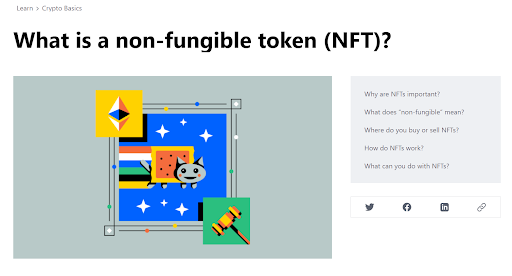
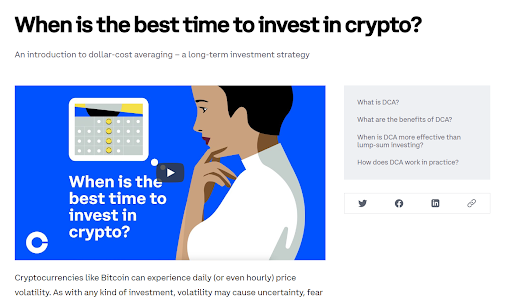
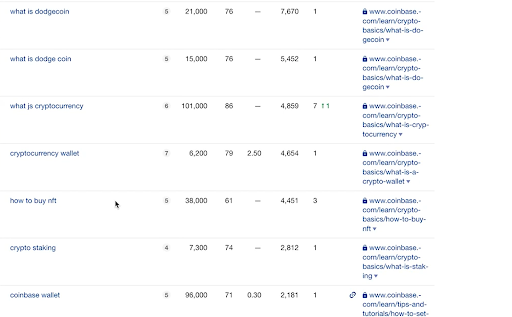
What is worth noting is that Coinbase has a different content format in the How To Buy section. It is straightforward with a short intro and a clear step-by-step guide on how to buy crypto. This is because a person searching for this query is likely to be in the buying mode – they already know cryptocurrency, and it is unnecessary to explain it again. Besides, it is said that Google loves showing lists for the “how-to” keyword. Although Google never confirmed it, a step-by-step instruction really makes it easier to see and digest. These tactics helped Coinbase rank high in important ToFu keywords like “how to buy Shiba Inu coin,” “how to buy dogecoin,” and “how to buy safe moon.”
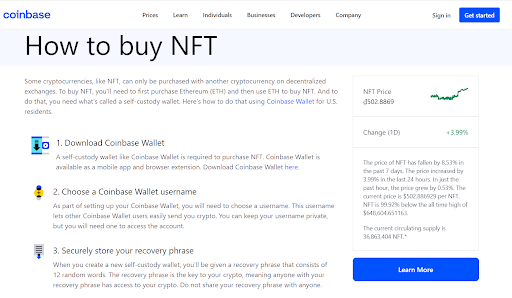
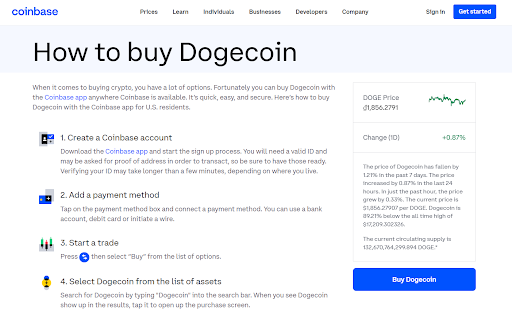
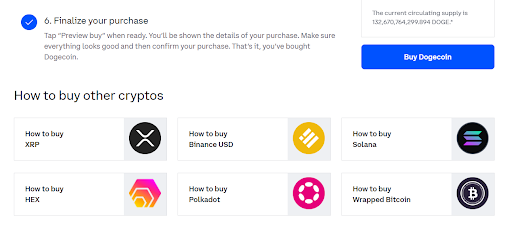
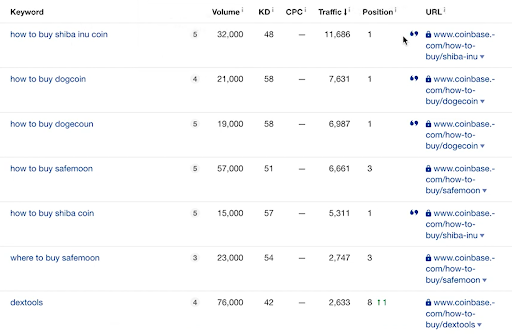
Takeaway: Understanding user search intent is essential if you want to rank high on Google. While it is great to optimize for keywords that drive traffic, ensure your content provides real value and is relevant to user search queries.
Money Pie
Acorns is a Fintech company that specializes in investment and banking. Launched at the end of 2014, the company is currently serving 8.2 million customers partly thanks to its genius branding and marketing strategy.
In April 2022, Acorns introduced a new show “Money Pie” where they partner with Angela Yee to bring financial education to YouTube. They interview some of entertainment’s big names about their money stories like experiences with investment, biggest financial regret, and how to bounce back after bad business deals.
The Money Pie show is a good combination of influencer marketing and educational content marketing. It aims to resonate with prospective users, with them, and become a to-go source for all things money and investment. Before “Money Pie”, the company partnered with industry experts to frequently conduct Q&A sessions and share money advice on Instagram and Youtube.

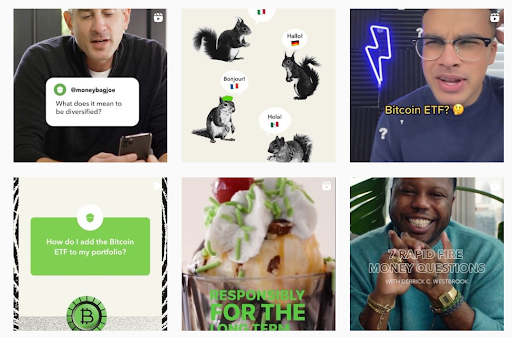
Takeaway: With the complicated nature of FinTech products, creating value-driven content plays a crucial part in educating customers and establishing credibility. Experiment with different kinds of content like video marketing, storytelling, influencer endorsement to find out what appeals the most to your target audience.
OVER TO YOU
With TikTok marketing, it is very important to find the right trend and content. Creativity plays a big role in this platform, together with authentic and entertaining content.
When you first get started, you would probably feel like your content doesn’t have the attention it deserves. Our advice is to be consistent. Keep posting on a regular basis, follow the TikTok algorithm and take advantage of the latest trends, and you are sure to be rewarded!
HOW CAN WE SUPPORT YOU?
If you are looking to scale your Fintech or Finance business with online marketing, we’re here to help. Contact us at alex@omnidigital.com.sg or visit www.omnidigital.com.sg
Instagram: @omnidigitalsg
TikTok: @omnidigitasg
LinkedIn: Omni Digital Pte Ltd
Personal LinkedIn: Alex Chan, CFA
The Marketing Funnel: Stages, Strategies, & How to Optimize
Best Fintech Marketing Strategies 2022
Content Strategy
Do you know that 47% of B2B buyers consume 3-5 pieces of content prior to engaging with a salesperson? A survey from Demand Gen Report indicated that B2B buyers prefer content that educates rather than just sells. They are looking for advice that helps them benchmark their strategies and success stories from others facing the same challenges. Below are seven types of content to build trust while educating your prospective customers:
- Case studies
- White papers
- Webinars
- Ebooks
- Video/motion graphics
- Infographics
- Podcasts
The same report also indicated that readers are shifting toward visual and easily digestible formats due to the large amount of content consumed every day. If your website is struggling with low-quality traffic, try writing a mix of both long-form and short-form content, and make it more engaging by including infographics, charts, video, and case studies.
An example of an effective content marketing strategy is Wealthsimple, one of Canada’s leading Fintech companies. The company created a digital magazine that allows readers to easily digest news about investment, business, cryptocurrency, and other emerging topics. As visuals are proven more powerful than text, the company created a unique look for all its marketing channels (website, app, blog, etc.) with eye-catching designs, infographics, and custom illustrations. Its strong focus on visuals helps the brand resonate with the mass millennials market and become the go-to source for investment and money advice.



Lead Magnets
Lead magnets are used to generate a steady stream of leads that later can be qualified and nurtured through the marketing funnel. They are basically anything that offers real value to customers, from white papers and reports to case studies and free trials.
In a B2B context, case studies are one of the most effective ways to promote your products and services. In fact, up to 73% of B2B buyers viewed a case study during their research since it provides compelling proof of a company’s abilities. It also helps brands build trust as people value the opinions of their peers over what businesses say about themselves. .
Pro Tip: A great way to create high-converting lead magnets is to put your content onto a landing page and direct traffic to it through paid ads. Another way is to leverage exit-intent pop-ups, which fit well with various content types such as webinars, case studies, and ebooks. Ensure that your pop-ups are easy to close and have a clear CTA.

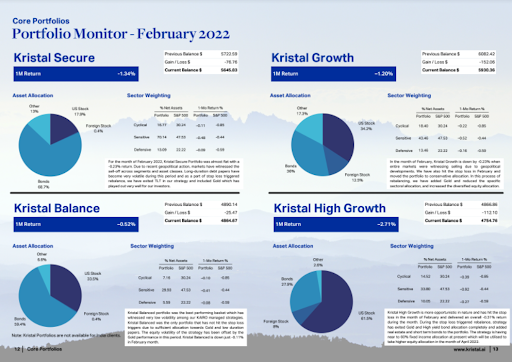

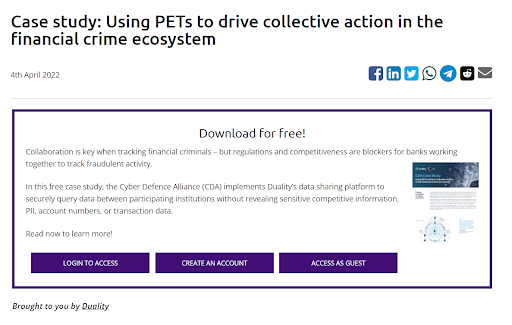
Hosting webinars is a common strategy for building awareness and reinforcing brand authority. Throughout the events, you can establish themselves as experts within a specific area, reach out and develop meaningful relationships with prospects. You can either team up with industry-related influencers to guest on your webinar or register to become a speaker at major events.
Founded in 2017, ADDX is a leading digital securities platform for private market investments in Singapore. The company regularly hosts webinars and invites external speakers to share on various topics like Private Credit, Web 3.0, Security Token. Participants need to register with their business information to join the webinar. They also share the events on different marketing channels to maximize exposure.
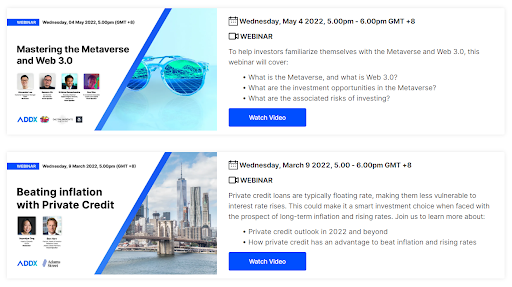

Email Marketing
Email marketing remains the leading marketing channel for nurturing potential and existing customers. Email Marketing Industry Report published by Econsultancy reveals that email marketing was the top-rated channel for ROI, followed by SEO and paid search.

Email marketing automation is a tool to help businesses personalize email at scale. It can leverage user data to segment their contacts, set up behavioural triggers and workflows to nurture leads and maximise the impact of their campaign. Accordion to Campaign Monitor emails with personalized subject lines are 26% more likely to be opened, and marketers have found a 760% increase in email revenue from segmented campaigns.
There are three ways that Fintech companies can use email automation to their advantage:
- Educate customers: Share educational content such as guidelines, checklists, downloadable templates, and reports.
- Entice and excite customers: Free subscriptions, customer referrals, or anything that makes them excited and triggers action.
- Win back lost customers: Set up an automated re-engagement campaign when customers haven’t engaged with your website or email for a while. It should include something that reinforces the company’s value and gives them an incentive to come back to your website.
SEO Strategy
Search engine optimization (SEO) is a long-term digital marketing strategy that helps websites rank higher in search engines, primarily on Google. According to research by Ahrefs, more than 90% of online content gets zero traffic from Google. So how can you be a part of the minority that gets organic traffic from Google? Here are five important factors that can have a significant effect on your Google ranking:
Keyword Research
We often recommend businesses utilize long-tail keywords, as they are less competitive and can result in higher conversion rates. In fact, long-tail keyword searches were found to have a click-through rate 3-6% higher than generic searches. This is because long-tail search queries typically occur when customers are moving down the sales funnel.
It is also important to target keywords for different stages of the funnel. For example, ToFu keywords should be broad and general as it aims to build awareness in the early buying stage. Meanwhile, BoFu keywords should be more specific and focus on how your product can effectively solve customers’ pain points.
User Search Intent
User Search Intent is the user’s main goal when typing a query into a search engine. Your content must stay relevant to user intent to rank high on Google. For example, someone searching for “what is bitcoin” is in research mode. They want to see educational articles that help them understand it. On the other hand, a person searching for “buying bitcoin in the US” is likely to be in buying mode, so Google responds to it by showing a long list of cryptocurrency platforms. More about user search intent will be shared in the case study.

Backlinks
While we all understand the importance of backlinks, it is interesting to note that not all backlinks are equal. There are two factors that contribute to an effective backlink: Authority and Relevance. Backlinks from trustworthy, authorized websites would hold more value than low-authority ones. Similarly, backlinks from industry-related websites can add more credibility to your content and move the needle in the search results.
Fresh Content
Freshness is more important for some queries than others. For example, the top results for “Singapore news” are articles published within one day. It even shows Top Stories with articles published from the past few hours. This is because Google wants us to stay updated with the latest news.
Keeping your content fresh by updating the latest Fintech trends and technology is a great way to drive organic traffic and become a part of the online conversation.
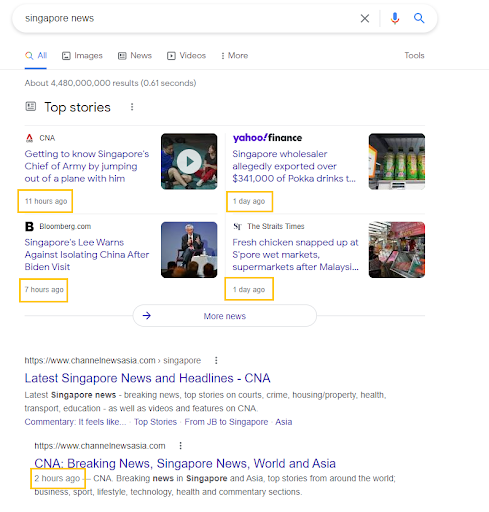
Page Experience
Page experience is another factor that Google takes into account when ranking a website. It is a set of metrics that measure how users perceive their experience with a website beyond its information value. Here are some of the metrics suggested by Google’s developer document:
- Mobile-friendliness: Users should be able to access the page via mobile.
- Security: The page should run on HTTPS.
- Browsing safety: Safe browsing checks for security issues including malware, deceptive pages, harmful downloads, and uncommon downloads.
- Loading performance: A fast server response time will result in better performance.
- Presence of intrusive interstitials: The content on the page is easily accessible to the user. This might include aspects like pop-ups and ads that intrude on the main reading experience.
Social Media
Having a Facebook page, a LinkedIn profile, or a Twitter account allows people to engage with your business online. In fact, companies with the most robust omnichannel customer engagement strategies retain an average of 89 percent of their customers compared with 33% for companies with weak omnichannel strategies.
Maintaining multiple social media channels can be time-consuming, so it is essential to invest in the right channel. LinkedIn is a go-to platform for B2B businesses. 82% of B2B marketers use Twitter as a part of their social media marketing strategies. Facebook and Instagram are powerful marketing channels for targeting young audiences and building brand awareness. Facebook is an excellent choice when it comes to audience targeting capabilities.
Step is a mobile banking service that targets millennials and Gen Z users. It has amassed over 2 million users since its launch in 2020 thanks to its hyper-focus on teens. The brand developed a solid social presence on various channels including Instagram, Twitter, TikTok, and Youtube. To resonate with young customers, their content covers various topics from money education, product updates to interviews with Gen Z founders, mini-games, TikTok challenges, or even horoscopes. Step’s social media marketing strategy is a great example of knowing your target audiences and building an emotional connection with them.
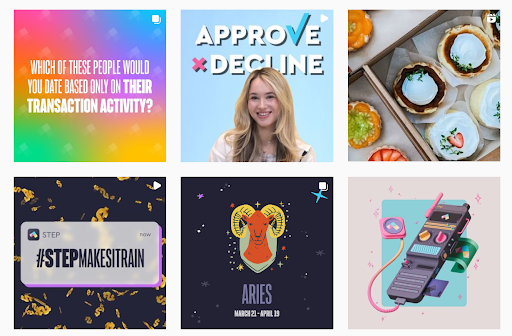
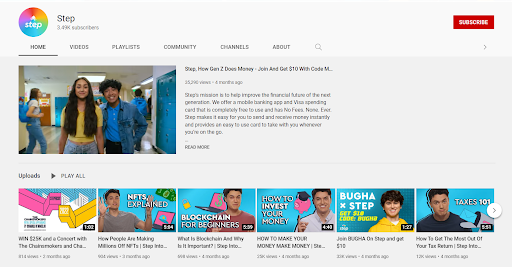
Paid advertising
Paid advertising is a digital marketing method that enables you to reach your targeted customers instead of waiting for them to find you. You can target them based on a wide range of criteria such as customer interest, demographics, search terms. SEM (Search Engine Marketing) and social media ads are the two most popular paid ad strategies at the moment. They can work with any budget and work well if they are combined with each other.
SEM
Paid search, or SEM, drives traffic to your website by getting your ads to show up on the search engine results pages (SERPs). Most businesses use the pay-per-click (PPC) model since it helps them reach their target audience and track their performance. Google Economic Impact Report found that PPC visitors are 50 percent more likely to make a purchase than organic visitors.
To increase the effectiveness of your ads, here are some factors to consider:
- A/B Testing: If you’re running paid campaigns for the first time, it is important to test different elements in your ads (audience interest, headline, images…). A/B testing allows you to see which ad performs best and optimize your campaigns over time.
- Google ad pricing is very flexible, so you can spend as much or as little as you want depending on your budget. However, as your bid for the keyword partially determines your ad ranking, it should be high enough to rank well and enable your ads to run efficiently.
- Determine the right keywords: Targeting different keywords for different stages in the buyer’s journey can help optimize the conversion. For example, someone searching a general query like “digital payroll solutions” is probably in the awareness stage. A landing page introducing your product and its benefits is more effective than a case study.
- Retargeting ads: Google has retargeting technology that allows brands to show ads to people who have already engaged with their business or searched for related terms on Google. For example, when a man leaves your website without making a purchase, you can display ads for the product that he previously interacted with. This is a great way to remind customers about your brand and keep you on top of their mind when they decide to make a purchase.
- Use tools to make your ads work better:
– Keyword research: Google Keyword Planner, Ahrefs Keyword Explorer, SEMrush.
– Campaign management: Google AdWord, Google Ads Mobile App.
– Tracking: Google Analytics, Google Ads Performance Grader.
Omni Digital is a full-service digital marketing agency that helps businesses scale through paid search and social. Our team of experts can help you set up, manage and optimize your ad campaigns to get the most out of your marketing budget.
Social media ads
Like PPC ads, paid social media ads use a bidding model to display ads to potential customers based on their behaviors and interests. If you are new at PPC, we recommend you spread out your campaign budget to multiple channels and see which one brings the most conversion. Running social media ads is an ongoing process with continual testing and refinement, so it will take a while to identify your best-performing channels and what messaging resonates the most with the audience.
Pro Tip: According to Target Marketing, 68% of marketers surveyed invest in social media retargeting. On Facebook alone, retargeting ads are 76% more likely to get clicks than regular ads. If your ads are not getting enough attention on social media, allocating some budget for retargeting can keep your brand at the forefront of your customers and increase your conversions.
1. Facebook Ads
Google Ads and Facebook are the two platforms that most companies start with. Instead of targeting keywords like Google Ads, Facebook ads are based on the audience’s behaviors, interests, or actions they’ve taken in the past. It has a complicated algorithm working in the background to make your ads visible to your target customers.
While the engagement on Facebook seems a bit cold, the secret to successful Facebook ads lies in wise audience targeting and retargeting ads. As of May 2022, the average CPC across all industries on Facebook was $0.931. However, a lot of advertisers don’t choose to pay for clicks on Facebook. They prefer paying for every 1,000 impressions (CPM). That said, the average CPM in May 2022 was $12.53.
Pro Tip: The Ad Library provides a comprehensive, searchable collection of all ads currently running on Facebook. You can use this tool to look up your competitors’ ads, when they run them, what ad types they use, and how they deliver the messages.
2. Instagram Ads
Just like Facebook, Instagram is great for building brand awareness. It’s a highly visual platform that includes both images and videos. In fact, video content has grown to have a major presence on the platform, as organic video posts and video ads get 38% more engagement than images on Instagram. Instagram has recently provided immersive full-screen mobile video opportunities, so marketers can have several places to post their ads: Instagram feed, Stories, and Reels.
If you’re wondering which is the best route for ads, AdEspresso suggests Instagram stories as it is relatively cheap but comes with high engagement. You can A/B test Story video ads and Reels ads to find out which one performs better for your objectives.
If you don’t have the time or resources to produce a video, we’ve got good news for you. A study by Social Insider found that carousel posts bring higher engagement rates than videos or images. Additionally, carousels with eight or more slides tend to perform better. When making use of all ten slides available, the average engagement rate goes over 2%.
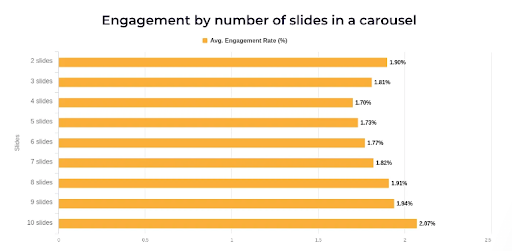
Pro Tip: Carousels with messages that encourage viewers to swipe left will result in higher engagement. These terms include any variation of swipe, swipe to see, swipe over, questions about which photo people like best, or even referrals to a slide number for extra information. This little detail in the caption boosts the average engagement from 1.83% to 2% per post, so keep this in mind when creating your carousel.
Here is a simple example of an Instagram Story Ad. Coinbase created a 15s explainer video providing a brief introduction of the company and enticed people to swipe up and explore it for themselves.
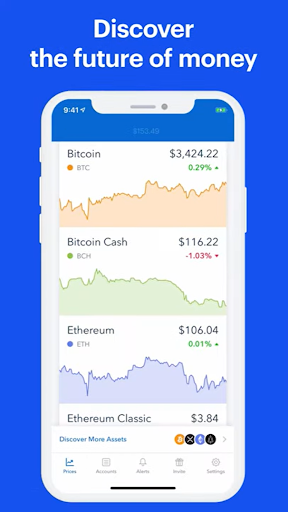
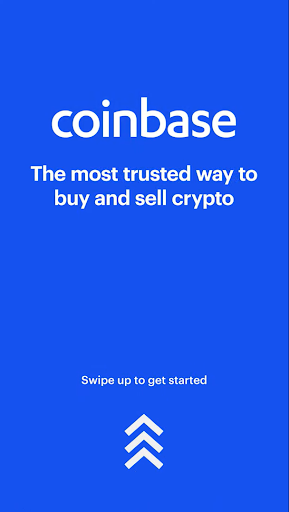
3. LinkedIn Ads
LinkedIn is a social networking platform for work professionals. Unlike other social media platforms, LinkedIn users tend to be work-focused, and you can target them based on their job titles, the industry they’re working in, where they work, and so on.
According to a report by The B2B House The CPC benchmark for Linkedin is $5.58 globally as of May 2022. If you’re targeting senior decision-makers, the average number can goes up to $6.40. Here are some of the most common job functions that marketers target on Linkedin, together with average CPC benchmarks:
- Accounting: $5.00
- Business Development: $6.30
- Education: $4.90
- Engineering: $5.10
- Finance: $6.90
- Human Resources: $6.00
- information Technology: $7.90
- Marketing: $6.80
- Media and Communications: $5.60
- Operations: $5.70
- Product Management: $7.30
Pro Tip: LinkedIn advertising tends to be pricier than other channels. Instead of running ads on this platform, having an active and solid presence on LinkedIn is a good alternative.
4. Youtube Ads
YouTube ad campaigns are hosted within Google Ads, so running Youtube ads is easy if you have already been familiar with Google Ads. Because video ads have the ability to capture attention better than display ads, brands are utilizing Youtube videos to increase their brand awareness and engage with potential customers.
Although YouTube ads function quite the same as the Google Ads interface, it has different bidding strategies. Below are some bidding strategies for Youtube ads:
- CPV (cost per view)
- CPM (cost per thousand impressions)
- maximize conversions ( when using the “drive conversions” video campaign subtype)
- Target CPA (tCPA) (when using the “drive conversions” video campaign subtype)
CPM is an important indicator when it comes to Youtube advertising. Companies can use this metric to compare the effectiveness of search engine ads or ads on different social media channels. The average CPM on Youtube varies a lot by industry. In 2021, the average YouTube CPM rate in Singapore is $17.
As a whole, a Youtube ad is a good choice for driving awareness and consideration (ToFu and MoFu stage). A video is also a great content source as it can be utilized for almost any media channel: Website, social media, or email marketing. However, brands should pay attention to the length of your ad. A video longer than 15 seconds will be skipped after 5 seconds, so ensure your videos grab the attention in the first few seconds.
If you are looking to grow your online presence on social media, we are here to help. Our team of social media experts will work closely with you to create and implement your social strategies, so you can generate sales, drive traffic, increase registrations and more.
Referral or Influencer Marketing
Referral marketing is a popular growth tactic that leverages word of mouth and recommendations. Below are some examples of how Fintech brands are implementing referral programs to get more referred customers:
Coinbase: As part of the launch strategy, Coinbase introduced a generous referral program to encourage users to spread the word about the app. When a referee initiated a buy or sell of a minimum of $100, Coinbase would pay a $10 commission to both the referee and referrer. This commission program attracted a lot of industry bloggers and influencers to sign up and promote Coinbase through their channels.
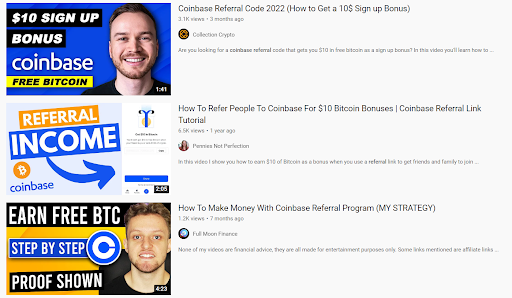
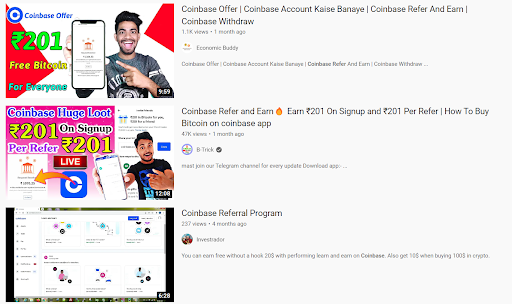
PrizePool: Launched in August 2020, PrizePool has its way to make saving money more fun: The company offers cash prizes guaranteed to total $50,000 every month based on your savings and spending habits (they publish a list of top winners every month). Interestingly enough, when you invite your friend to use PrizePool, and that friend wins the prize, you will also win 10% of the prize!

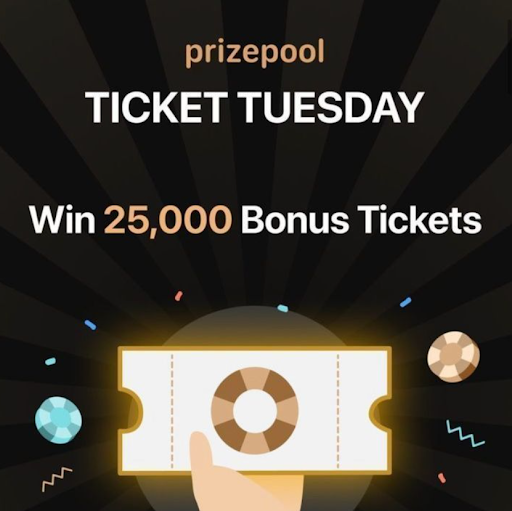
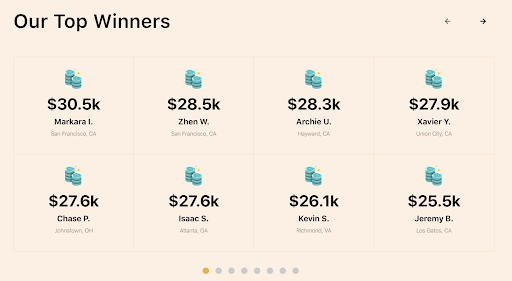
Revolute: Revolut is one of the most valuable Fintech startups in England. They created the Revolut Pioneer Program to increase brand exposure by partnering with carefully selected influencers and offering them attractive referrals and incentives.
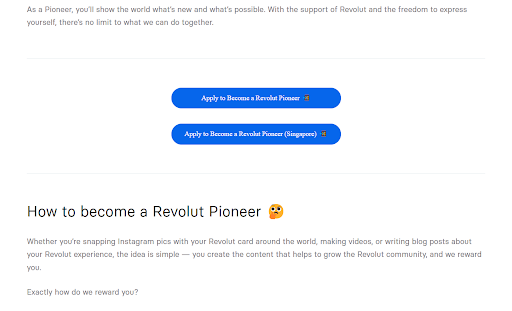
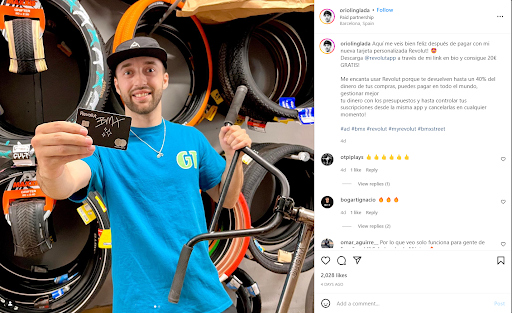
How to Build a Conversion Funnel That Will Triple Your Profits
What is Fintech Marketing?
Fintech is one of the fastest-growing industries with companies innovating in many areas of finance and billions of investment dollars flooding into the ecosystem. According to KPMG, the global fintech investment was $105 billion in 2020 and is expected to reach $179 billion by the end of 2022 with around 30,000 FinTech startups worldwide. In addition to startups, established firms have been investing in disruptive technologies to improve their financial services and retain a solid position in the Fintech industry.
Along with the steep competition, Fintech companies pose a number of challenges: Lack of trust and credibility, cybersecurity, increasing regulation, changing customer needs and behaviours. While developing great products and services is important, it is crucial to deploying the right marketing strategy to cut through the noise.
In recent years, we have seen significant changes in the way Fintech firms run their marketing operations. Some have managed to stay ahead of the curve with their effective sales funnel and unconventional approaches to nurture customers through different stages of their journey. In this ebook, we will look into the time-tested marketing strategies for Fintech companies and lessons learned from their successful marketing campaigns.
Build The Right Sales Funnel
Do you know that up to 73% of leads were NOT sales-ready and 79% of leads never converted into sales? Collecting a long list of marketing qualified leads (MQLs) sounds impressive, but it does not necessarily bring more sales. This raises the question of how to build an effective sales funnel that can help you turn your prospects into fully engaged customers.
A sales funnel starts with potential customers being aware of your product and ends with them taking action on it. There are typically three main stages in the sales funnel: The Awareness Stage, Consideration Stage, and Decision Stage. Each stage is tied directly to a buyer’s intent and with different strategies to move them down the funnel.
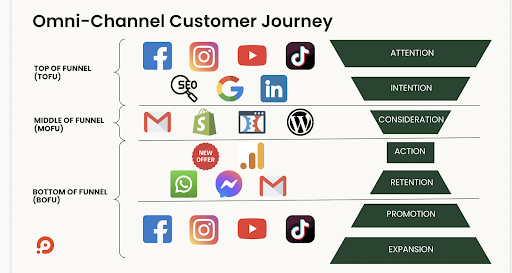
Strategies for Every Stage of the Sales Funnel
Top of the Funnel (ToFu)
This phase, also known as the Awareness Stage, is when your prospects are doing educational research to understand the problems and different solutions. They might find you in various ways, like your SEO efforts, social media, and paid ads. Here are several ways to keep your company at the forefront of your potential customers:
- SEO/Blogging: An effective SEO strategy would improve your website’s placement in search results and help it appear on Google’s first page.
- Lead magnets: Lead magnets are incentives in the form of exclusive content (eBook, report, template).They are effective for capturing and nurturing leads.
- Social media: Research showed that 72% of B2B buyers use social media to look for solutions to their problems. If social media is not something you are utilizing to increase your company’s visibility, then it may be time to start.
- Paid ads: Paid ads are the quickest way to allow potential clients to discover your company. More on this later.
Middle of the Funnel (MoFu)
The MoFu stage is when customers are considering different solutions they found. This is when you should start engaging more with your customers through email marketing, paid ads, and retargeting ads. Here are some effective MoFu marketing strategies to focus on:
- Email marketing: Email marketing works well for lead generation and lead nurturing. It can effectively promote products and services through different email campaigns and audience segments.
- Retargeting ads: Retargeting ads are a form of paid ads that target people who have engaged with your business before or are a contact in your database. According to Invesp, retargeting ads result in 10 times more clicks compared to standard display ads. More on retargeting ads later.
Bottom of the Marketing Funnel (BoFu)
The final stage is when your customers make the purchase decision. At this stage, the sales and digital marketing agency in Singapore team should work together to convert leads into customers. Content such as case studies, product comparisons, testimonials, and free demos helps reinforce customers’ confidence in your product and encourages them to go for a sales call. It is advisable to continue running retargeting ads highlighting your products or giving a favorable offer.
The Complete Guide 2022 to TikTok Marketing
How the TikTok Algorithm Works
The TikTok algorithm is a complex system designed to display videos relevant to your preferences and interests. That’s why the For You page is highly personalized for each individual user, as no two users will see the same videos on this page. This also means that the types of content you are recommended can also be changed as your interests change over time.
Factors that Influence the TikTok Algorithm
- User interactions: The videos you like or share, accounts you follow, comments you post, videos you add to your favorites, content you create, etc.
- Video information: Captions, sounds, trending topics, and hashtags.
- Device and account settings: Your language preference, country setting, device type, and categories of interest you selected when logging in. These factors are included to make sure the system is optimized for performance.
According to TikTok, some indicators are stronger than others: “A strong indicator of interest, such as whether a user finishes watching a longer video from beginning to end, would receive greater weight than a weak indicator, such as whether the video’s viewer and creator are both in the same country. Videos are then ranked to determine the likelihood of a user’s interest in a piece of content, and delivered to each unique For You feed.”
Note: TikTok does NOT base recommendations on either follower count or whether the account has had previous high-performing videos. This means that even when you don’t have a huge follower base, but your videos speak to the audience, you will have as much chance to land on the For You page as other accounts.
What the TikTok Algorithm Doesn’t Show
As part of its content optimization, there are certain types of content that will not be showcased on your For You page:
- Videos you’ve already watched
- Duplicated videos
- Spam content
- Videos you’ve marked as “Not Interested”
- Videos you skip through
- Potentially harmful/upsetting videos
How to Create Viral TikTok Videos
1. Use the 3-second rule
Tiktok is a fast-paced app, so the first 3-5 seconds are critical. Ensure your content is eye-catching and engaging enough to grab people’s attention in the first few seconds. Otherwise, the algorithm will define your content as irrelevant or not interesting and will not boost your content.
2. Understand trends
It is important to spend a little time every day watching videos on TikTok. This helps you spark new ideas and keep up with the ongoing trends. In fact, 61% of TikTokers like brands better when they create or participate in a trend on TikTok. However, every trend has its moment. They come and go very quickly, so If you don’t jump on them fast enough, you’re likely to get lost in the shuffle.
Sephora Asia is famous for having an active presence on social media. Its creative content garnered 66k followers and more than 2.9M likes on TikTok. Earlier this year, when TikTok’s For You page was filled with the #telephonechallenge, @Sephora_asia quickly caught this trend and attracted 9k views on TikTok with their video.

3. Use Hashtags & Trending Songs
Hashtags and songs are your friends. According to studies from MRC Data’s research, 67% of TikTokers said they prefer to see videos from brands featuring popular or trending songs on TikTok, and 68% said they remembered the brand better. To resonate with the audience, opt for hashtag challenges to participate in them.
A prime example of leveraging trending songs and hashtags is @Duolingo. Their TikTok account is a combination of short, humourous videos featuring their lovable owl mascot, together with trending audio. The consistency in content creation and sense of humour has garnered this brand 4.2 million followers and 97.7 million likes as of May 2022.
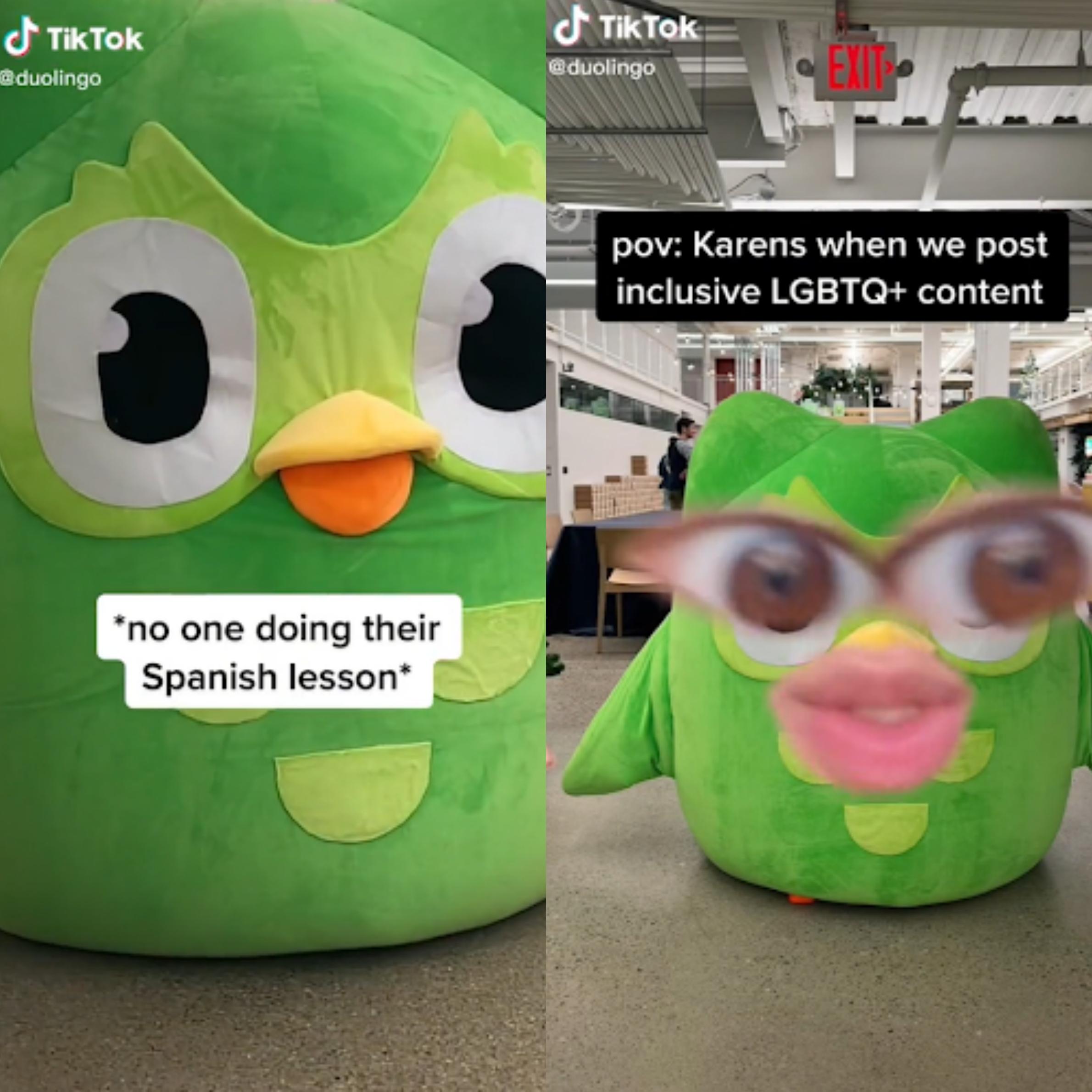
4. Create Branded Hashtag Challenges
There are two ways to go about TikTok challenges: Either you follow it or you create your own challenge. When brands sponsor a hashtag challenge, it’s called a Branded Hashtag Challenge. This is an incredibly effective way to generate buzz about your brand.
As mentioned, the challenge should be fun and easy to follow – the audience can be challenged to do some action while dancing to a funny song, reinvent an influencer’s video, or participate in a contest. Here are a few ideas for branded hashtag challenges:
- Branded Effect: Create a unique 2D or 3D effect.
- Hashtag Emoji: Customize the brand emoji that appears alongside the hashtag.
- Contest: Leverage user-generated content by creating a contest with a sweet prize.
Explore Page: Adds an “Explore” tab to the challenge page, which will lead to a customizable landing page within the TikTok app. You can use this way to gain more exposure for new products or offline stores.
5. Share Tips, Advice, or Interesting Fact
Do you know that 45 percent of TikTok users feel more connected to brands that teach them something new? Sharing tips and advice on TikTok helps brands not only resonate with their followers but also build up their credibility. In fact, educational videos can be applied to a variety of brands, from beauty, fashion to fitness, or even software.
A typical example is @thehoneycombers, which provides the audience with tons of engaging content, from food reviews, cooking tutorials, to fun things to do in Singapore. Another example is @coachjasonho. As a TikTok influencer, he is famous for sharing his thoughtful advice on career and work-life struggles. His recent 2-minute video How to say NO to your boss gained him 26k views on TikTok.

6. Leave Some Questions Unanswered
Interaction is the key to helping you go viral on TikTok. If you post a video and think of a question that most people would have, don’t explain it yet. Raise that question at the end of the video and ask the audience to comment on their answers. Even better, say that you will explain it in the next video coming on [specific day]. This will make people curious and come back for more.

7. Collaborate with TikTok Creators
The power of TikTok influencers cannot be denied. By collaborating with influencers whose followers match the target market, brands are able to tap into their targeted audience, build interest in their products, and drive more leads. If your business is in the beauty or fashion industry, optimising influencer marketing on TikTok via TikTok Marketing Agency could be a game-changer.
Daniel Wellington (@danielwellington) is one of the brands that invested heavily in influencer marketing. The concept behind its strategy is simple yet effective: They frequently gift free watches to influencers together with discount coupons in their names to share with their followers. Creative control remains with the influencers – the only requirement is to use branded hashtag #danielwellington, #danielwellingtonsg (if the influencer is based in Singapore). The brand has recently started partnering with TikTok influencers to grow its presence on this platform.
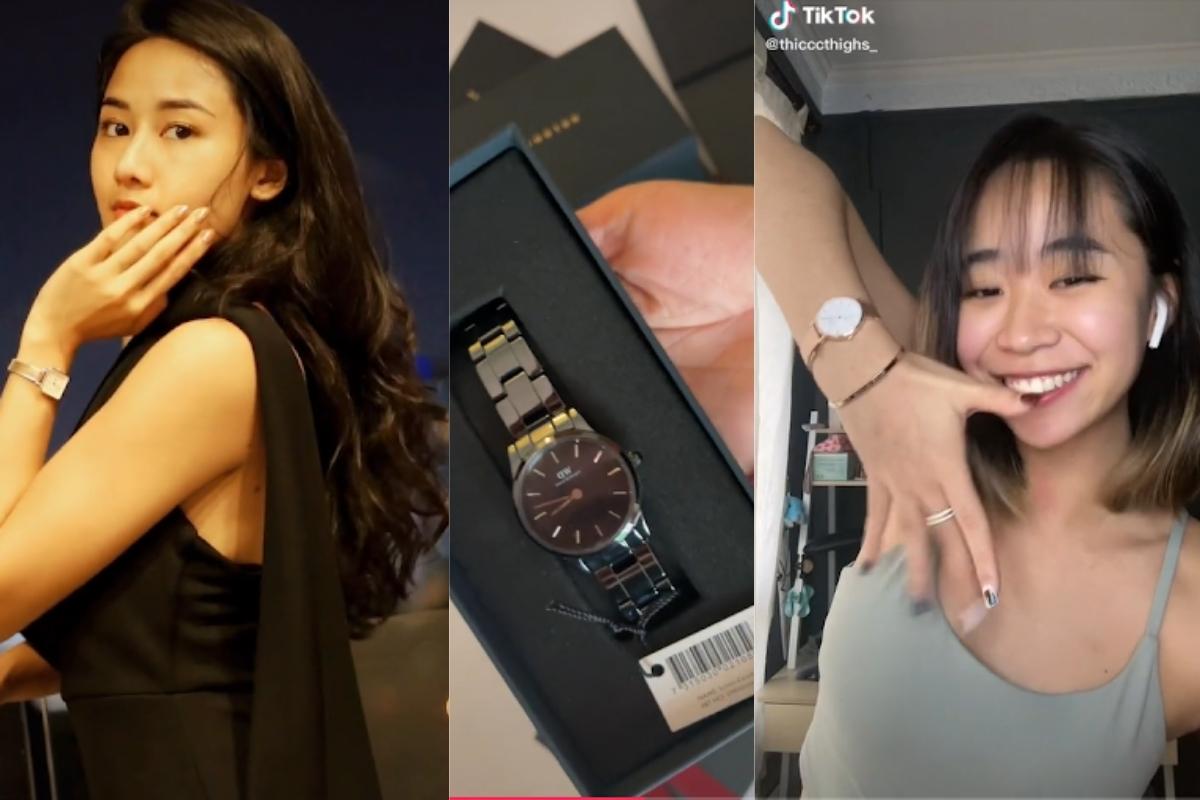
Define Your Target Audience
While TikTok offers a great opportunity for brands to gain visibility, ensure TikTok’s demographic fits your customer profile. If you are selling B2B software, having a presence on TikTok may not be necessary. If your audience demographic is middle-aged people, you would have a tough time finding your target customers here.
It is important to note that while TikTok is dominated by Gen Z and Millennials, older groups are also jumping on the TikTok train, particularly 25-34 years old who started using TikTok during the Covid-19 lockdown. Besides, women are just slightly more than men on TikTok (57% and 43%, respectively), so brands have equal opportunities when it comes to approaching male and female customers.
Define Your Goals on TikTok
What do you want to achieve with TikTok marketing? A majority of businesses come to TikTok with the aim to increase their visibility and reach out to new customers. While a study showed that TikTok drives greater engagement, there is no evidence this app is better at driving leads compared to other social media platforms. Lots of views, shares, and comments don’t necessarily mean people would buy your products. It simply means that they like your videos and your brand, which is a positive indicator.
Do Your Research
It is crucial that you spend time researching and learning from top-performing competitors in your industry. Look for brands that are doing well on the platform and identify what elements contributed to their success. Here are some factors you may want to look out for:
- What types of content do they use? What hashtags?
- What are the messages?
- What time do they post?
- Do they partner with any influencers?
- How do they create the sponsored content?
Note: We don’t recommend you steal from your competitors, as there is no one-size-fits-all approach. It is always good to look around and take some inspiration, so you will know where and how you should start.
Develop TikTok Content Strategy
Your content should be authentic and relevant to your target audience. TikTok is a playful and informal platform, so don’t feel the need to create sophisticated content. Additionally, you also need to find a natural fit between the product and TikTok videos. Here are some types of content you can take into consideration:
- Behind-the-scenes
- Live-streaming
- TikTok challenges/trends
- Educational content
- Influencer partnership
- Advertising (more on that later)
Use Advertising on TikTok
In-feed ads / In-feed Native Videos
In-feed ads are the most popular form of TikTok advertising. They run on three models: CPM (cost per impression), CPC (cost per click), and CPV (cost per 6-second view). Brands can create a target audience based on age, gender, and location. There are options to add links and call-to-action buttons.
The minimum campaign spend for daily budgets and total budgets is over 50 USD. For ad groups, daily budgets must exceed 20 USD. You can always go to TikTok Ads Manager to stay updated with its budget requirement. Apart from the number of views, likes, and comments, brands can measure their ad performance by looking at click-through rate and cost per click. A good click-through rate should be above 1%.
Hashtag Challenge Ads
Hashtag challenge ads promote branded hashtags to encourage users to participate in the challenge. They appear as a banner on the discover page, redirecting the users to an instruction page for joining the challenge. If done right, the branded hashtag challenge can result in meaningful connections and huge user-generated content. However, it comes with a high price tag.
According to Influencer Marketing Hub, the average cost for hashtag challenge ads has a flat fee of $150,000 for six days. The number is updated until September 2021 and is subject to change. If you are a small business, we recommend you create and promote your hashtag challenge organically.
Branded Effect Ads
Like Instagram filters and Snapchat branded lenses, TikTok allows brands to create an ad with their own custom filter. The branded effect ads can be run for up to 10 days, and it is a fun way to encourage people to engage with your business. Even better, use a combination of a Branded Hashtag Challenge paired with a Branded Effect to make your content go viral.
Brand Take Over Ads
With a brand takeover ad, ads are displayed when users open the app, so brands can get immediate attention from their targeted users. Given the format, this ad is best suited for awareness campaigns. However, TikTok only allows one brand to take over a category a day, so you need to pay premium prices for this spot. According to a report, the average cost for a brand takeover ad is around $50,000 per day with 5 million impressions guaranteed. The number can vary depending on your ad campaign.
Shoppable Ads
TikTok is building its influence in eCommerce. Shoppable ads, or Hashtag Challenge Plus, is a new form of ad that includes a shoppable component to a hashtag, directing users to shop within TikTok. Brands who are Shopify merchants are able to connect their TikTok’s Business account with their Shopify account and advertise on TikTok via in-feed shoppable video ads.
Since this is a new feature, it is currently available to merchants in the United States and the United Kingdom. If you have a Shopify store with a business address in the US or the UK, you can try setting up TikTok shopping partner Integration on Shopify.
Track and Analyze Your Performance
TikTok Pro account is currently free for all users. It offers valuable insights that help brands and influencers analyze their performance such as weekly views, trending videos, engagement, and traffic sources. Here are 3 simple steps to set up a Pro Account:
- From your profile page, tap on the 3-line icon on the top right to access settings.
- Choose “Manage My Account” and then “Switch to Pro Account”.
- Choose either Creator or Business account, and fill in the required information.
Once your Pro Account is activated, you will see an analytics button under your account options. Simply tap into that to open the Analytics tool.

1. Create a TikTok Ads Manager Account
Step 1: Create your login
Go to TikTok Business https://ads.tiktok.com/i18n/signup/ to sign up.

Step 2: Complete your account setup
Provide basic information about your business, including country/region, time zone, your preferred currency for billing, and business name. Double-check to ensure the information is correct. The Time Zone can not be changed later, and the “Business Name” of your account must be the same as (or closely related to) your company’s legal name.
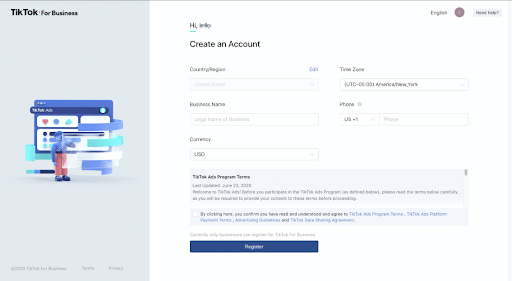
Step 3: Enter your business information
You will see a dashboard where you can enter your business and billing information. From the “Account Settings”, click “Account Info”, and complete the Business information.
In the company website box, enter your company’s website in the following format: https://www.tiktok.com/. The website should function properly, contain the required contact information, and be relevant to the product or service you want to promote.
For Business Verification, upload a government or officially issued number that you use to do business or pay taxes in your country, but this is optional.

Step 4: Select a Payment Method
Choose your Payment Type: Manual Payment or Automatic Payment. We recommend you choose Manual Payment, as Automatic payment is not available in all markets at this time.
Please note that the payment method is set up, you will not be able to change it.
Step 5: Submit Account Information
After you submit your account information, TikTok will start reviewing your account. This process can take up to 24 hours. There are 4 common reasons why a TikTok account is not approved:
- The “Business Name” doesn’t match the name on the website and official documents.
- The company website is in the wrong format. It should look like this: https://www.tiktok.com/.
- The company website does not clearly promote a product and/or has no valid information on the landing page. You can read more about TikTok’s requirements for the landing page in TikTok Advertising Polices – Ad Creatives.
- The promotion of the products or services may be prohibited in your market (cigarettes, flamethrowers, etc)
Set Up A Campaign
TikTok Ads Manager structures ads into three parts: Campaigns, ad groups, and ads. A campaign is an overall activity, while ad groups and ads are the functions within the campaign.
Step 1: Login
Log into the TikTok Ads Manager. Click on the Campaign button located at the top of the page, then click “Create” to start creating your campaign.
Step 2: Choose your objective
TikTok’s ad has seven objectives, which fall under three categories: Awareness, Consideration, and Conversions.
| Category | Objective | Business Goal |
|---|---|---|
| Awareness | Reach | Increase awareness and expand reach beyond existing followers |
| Consideration | Traffic | Drive users to any URL |
| App installs | Drive users to download an app | |
| Video views | Maximise the number of times your ad is played | |
| Lead generation | Collect leads with a customizable instant form | |
| Conversions | Conversions | Encourage users to take specific actions |
| Catalog sales (new) | Create personalized product ads based on your product catalog |
Step 3: Set up your campaign name and budget
Campaign name is up to 512 characters.
If you prefer to set the budget limits for specific ad groups rather than the whole campaign, you can set No Limit to your campaign budget. Otherwise, you can set a daily or lifetime budget for your campaign.
Campaign Budget Optimization (CBO) allows you to optimize a single set of budgets for all the ad groups that belong to your campaign rather than setting it individually. You can read more about Campaign Budget Optimization here.
Now, we are done with the campaign level. The next step is to set up the ad group.
Set Up the Ad Group
There are 5 factors to work with at the ad group level:
– Ad Placements
– Creative Type
– Target Audience
– Budget & Schedule
– Bidding Method & Optimization
Note: Within a campaign, you can have different ad groups for different audiences. Please keep in mind that the placement setting cannot be changed after an ad group is created.
Step 1: Select the ad placements
Ad placement is where your ad will appear on TikTok. With “Automatic Placement”, you will allow TikTok to optimize delivery across all placements. With “Select Placement”, you can select manually where you wish to deliver your ads. There are three main placements in TikTok Ads Manager:
- TikTok placement: In-feed ads on the For You page.
- News Feed App placement: Ads within TikTok’s other apps—BuzzVideo (Japan), TopBuzz (US and BR), Babe (Indonesia), and NewsRepublic (worldwide).
- Pangle placement: The TikTok audience network.
Not all placements are available in all locations. It depends on the ad type, targeting, ad creation, and country of delivery. You can learn more about your placement options here.
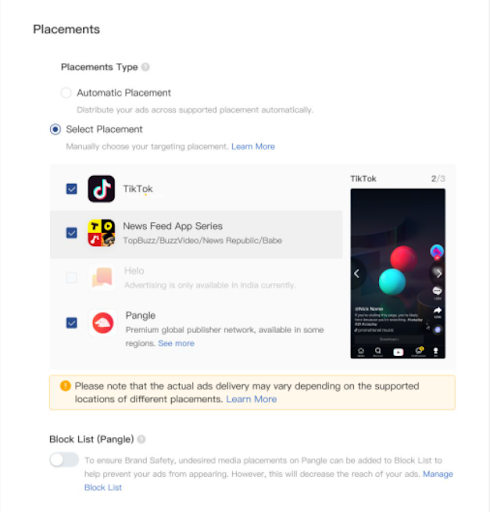
Step 2: Choose the desired creative
When you turn on Automated Creative Optimization, the system will automatically generate combinations of your creative assets (images, videos, and ad texts), and deliver only the high-performing combinations. TikTok recommends that new advertisers turn this setting on.

Step 3: Choose your target audience
TikTok allows you to create custom audiences just like Facebook. There are numerous audience targeting filters for you to select such as age, gender, interest, location, and operating system.
Step 4: Set the budget and schedule
- Budget: You can select a Daily Budget or a Lifetime Budget.
- Schedule: You can choose a date range to run your ad or continuously run your ad after the start date.
- Dayparting: You can select certain time periods within the day. If you select All day, the ads will run throughout the day during the scheduled time. If you choose Select Specific Time, the ads will run at specific time periods.
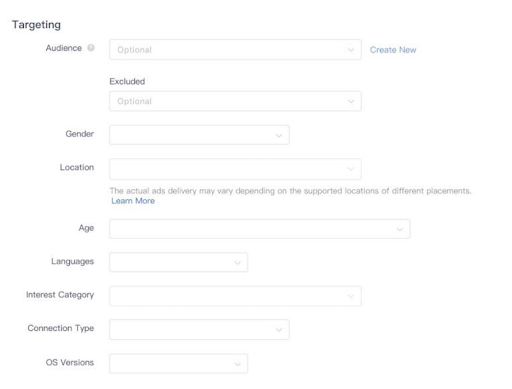
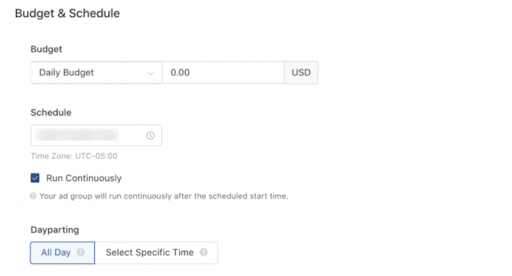
Step 5: Set up the bidding and optimization
1.Optimization goal
There are three goals to choose from. Once your optimization goal is set, the system will automatically set the billing event:
- Conversions: Your bidding method is oCPM (optimization Cost Per Mile) and the payment method is CPM.
- Clicks: Your ad will be billed as CPC (Cost Per Click)
- Impressions: Your ads will be billed as CPM (Cost Per Mille).
2. Bid strategy
- Bid Cap: Indicate the maximum amount per click (CPC), per view (CPV), or per 1,000 impressions (CPM).
- Lowest Cost: The ad system uses the ad group budget to generate the maximum number of results possible at the lowest cost per result.
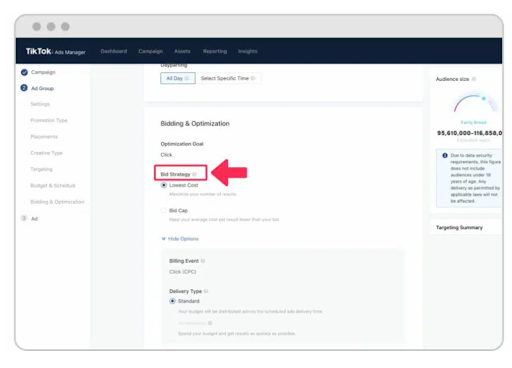
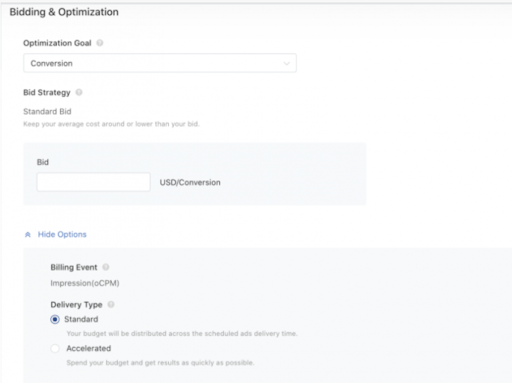
3. Bidding
Set how much you are willing to pay per thousand impressions, per click, or per conversion.
4. Delivery type
- Standard: Your ad budget will be spent evenly during the scheduled time.
- Accelerate: Your budget will be spent as fast as possible during the scheduled time.
Important: Once your ad group is created, the Start Date, Optimization Goal, Conversion Event, and Smart Optimization cannot be changed.
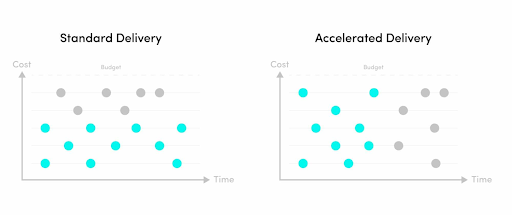
Set Up An Ad
We know! Finally, we can make an ad! All you need do is to upload your creatives, fill in some details, and submit.
First, enter your ad name and select the ad format. TikTok supports two types of ads: Image and video ads. Then you can upload your creative with three options:
- Add from Computer: Upload video directly from your computer.
- Add from Assets: Access and select your previous ads.
- Create a Video: Create a new video by selecting either “Use Video Template” or “Smart Video”.
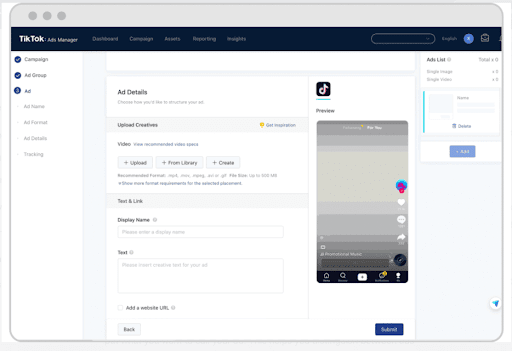
For the cover photo, you can choose one of the default thumbnails or upload your own photo. Then enter your text and link. When you are done, don’t forget to check the preview to see how your ad looks like.
For tracking, TikTok allows brands to add third-party tracking URLs and pixels to track their ad performance. You can learn more about TikTok pixels here and see a list of supported third-party tracking partners. When you are done, click the “Submit” button to trigger the ad review process.
5 Tips To Optimize Your TikTok Ads
Choose the Best Audience for Your Campaign
Make sure your TikTok ads are placed in front of the right people. You can filter them with multiple dimensions including gender, location, interest, and more. The other way is to consider letting TikTok create Lookalike Audiences – the audience groups that share similar profiles with your current customers. This can increase the chances of the audience viewing and engaging with your ad. More about Lookalike Audience can be found here.
Have a strong CTA
Do you know that replacing “you and “your” with “I” and “my” can lead to a 24 percent increase in conversions? This is because using first-person pronouns can make visitors feel connected and get the personal benefit of clicking.
Of course, an effective call-to-action button is not as simple as just using first-person pronouns, but you get the idea. An example of playing with your CTA is from Daniel Wellington. Instead of using the popular CTA “Shop now”, the brand made it a lot more interesting: “We’re throwing some shade with our new eyewear collection. Are you in?”.
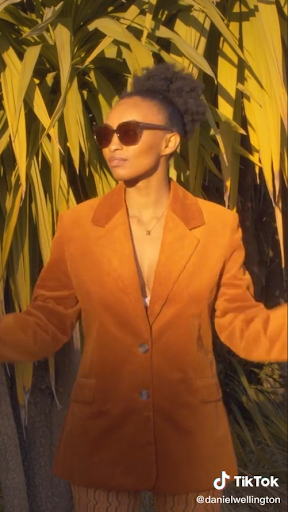
Have a diverse set of content
We all know engaging content is critical to success, but here’s another thing about it: It should be diverse. The platform recommends brands develop a set of five to six different creatives per ad group. These creatives keep your campaign fresh and relevant —without boring audiences.
Experiment with Bid & Budget
According to TikTok, brands looking to optimize conversions should tailor their strategy to have at least 50 conversions per week. If you are starting out on the platform, begin your campaigns with a 1.2x – 1.5x your typical cost per acquisition (CPA), and optimize the bid price from there.
Here is a list of the different ways you can bid TikTok. If you want to experiment with different bidding strategies and compare the performance, use the Split Test function to run an A/B and select Bidding & Optimization as your variable.
Do A/B test
From creative, target audience to bidding strategy, conducting A/B tests is an ideal way to optimize your ads, especially if you are new to the platform. Make sure all other variables are constant, so you can measure the impact of the testing variable.
Note: Avoid testing during the holidays and other seasonal moments, as this can skew your test results.
What is TikTok Promote
TikTok Promote is another advertising tool to help TikTok users promote their organic videos. It is an easy and effective way for brands to increase visibility and send leads on their websites. Below are some analytics that TikTok Promote offers:
- The number of views, likes, comments, and shares
- The number of people who visited your website link.
- The age and gender of the people interacting with your content.
For this type of campaign, you can only promote public videos with original sound, or a sound specifically created for commercial purposes. The Promote feature isn’t available for videos containing copyrighted sounds.
Here’s how to make your organic video more visible with TikTok Promote.
Set Up a Promote Video
Step 1: Set up your campaign
There are two options to set up the campaign. You open the video you want to promote, tap on the three dots near the bottom-right corner, then tap the Promote button.
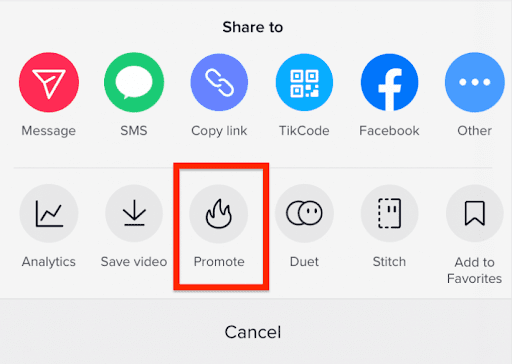
Another way is to access settings from your profile page. Tap on the 3-line icon on the top right in your profile page, tap Business suite, then tap Promote.
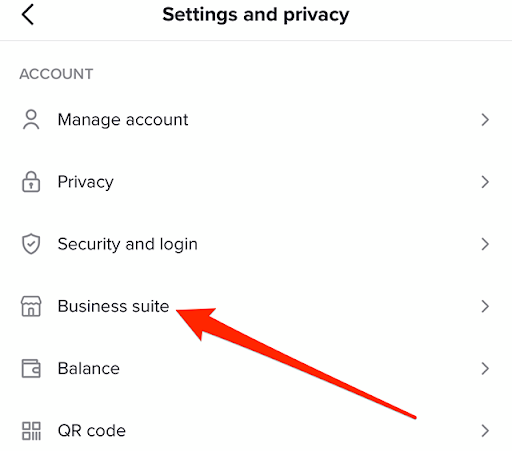
Step 2: Choose a goal for promoting your video:
- More video views.
- More website visits.
- More followers.
If you choose “more website visits”, enter your website URL and choose an action button for your website.
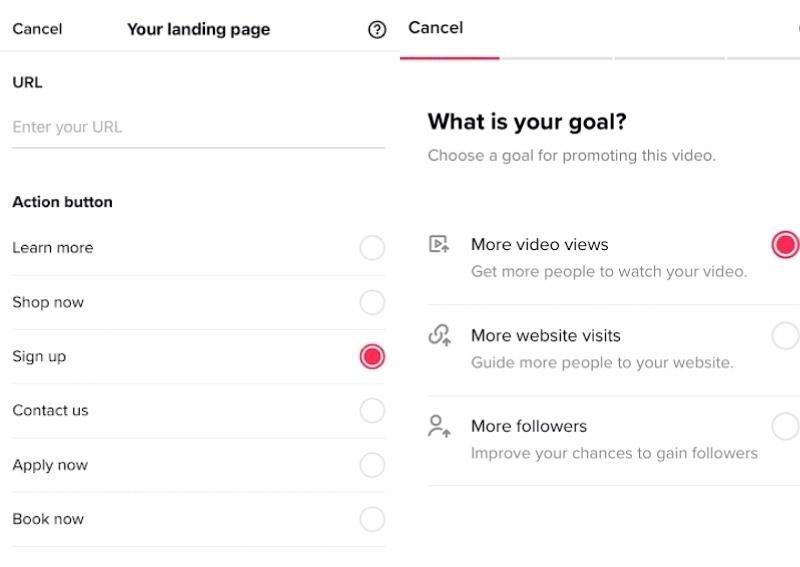
Step 3. Target your audience. You can choose from:
- Automatic: TikTok will choose the audience for you.
- Custom: You can do it manually by choosing genders, age, and interests.
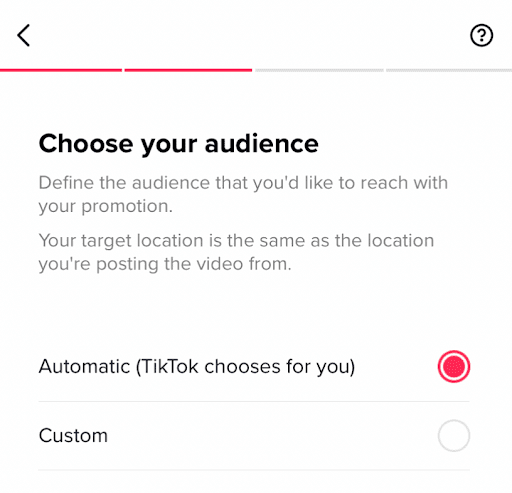
Step 4: Set your budget and duration
If you use an Android device, you’ll need to add payment information before submitting your ad for review. If you’re an iPhone user, you can recharge your account with virtual coins.
Step 5: Have your campaign reviewed
Tap Start promotion to allow TikTok to review your campaign.
Analyze Your Performance
Once a Promote video is live, you can check your video’s performance. Simply tap on the three dots in the bottom right corner of the post, and tap the Analytics button. It will show information including:
- The status of your video (pending review, active, paused, or rejected).
- The number of views, likes, comments and shares.
- Average watch time
- The number of link clicks (if you chose to promote your website).
- The number of unique users who see your video.
- Age range and gender percentages.
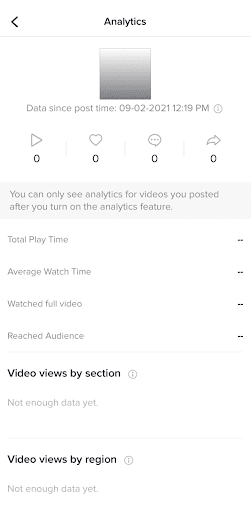
To track your follower growth rate, go to Settings and Privacy > Business Suite > Analytics. You’ll find analytics for your entire account, including engagement metrics, content, and follower information.
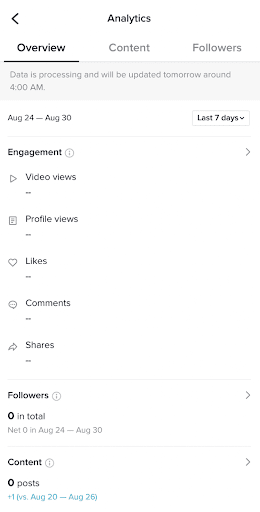
OVER TO YOU
With TikTok marketing, it is very important to find the right trend and content. Creative, authentic and entertaining content plays a big role in this platform.
When you first get started, you would probably feel like your content doesn’t have the attention it deserves. Our advice is to be consistent. Keep posting on a regular basis, follow the TikTok algorithm and take advantage of the latest trends, and you are sure to be rewarded!
HOW CAN WE SUPPORT YOU?
If you are looking to scale your business with TikTok ads or other forms of paid online advertising, we’re here to help. Contact us at alex@omnidigital.com.sg or visit www.omnidigital.com.sg
Instagram: @omnidigitalsg
TikTok: @omnidigitasg
LinkedIn: Omni Digital Pte Ltd
Personal LinkedIn: Alex Chan, CFA
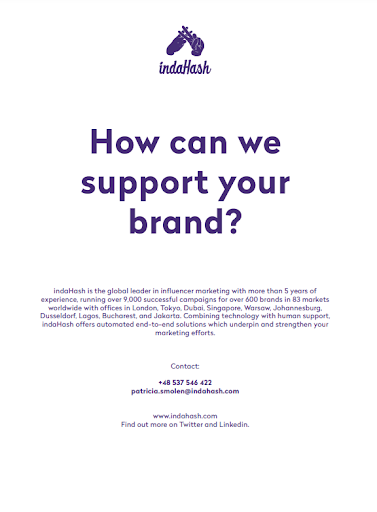
What is TikTok? How is it different from other social media?
For a long time, businesses didn’t take TikTok seriously. A lot of businesses considered it as a platform for Gen-Z to watch short, funny videos. However, when its user growth increased in 2020 (1157.76% increase in TikTok’s global users between Jan 2018 and July 2020), brands started to realize that they shouldn’t miss out on this major marketing chance. In Q4 2021, TikTok had 1.2 billion monthly active users and is expected to reach 1.5 billion by the end of 2022. Given the rapid growth rate and an increasing amount of time spent on the app, it is never too late to invest in TikTok for your business.
We have put together this complete guide that covers everything you need to know about TikTok: Why you should use TikTok for your business, how to create viral videos, and most importantly, how you can run successful marketing campaigns on TikTok via TikTok Marketing Agency. Here we go!
What is TikTok?
TikTok is a social media app that allows users to create and share short-form, entertaining videos. While other social media platforms are focused on images and text, TikTok is all about videos. Over the past few years, TikTok users have grown exponentially, particularly among the younger generation. Below are 10 TikTok statistics you need to know:
- TikTok was the most downloaded app in 2021 with over three billion times.
- In Q4 2021, TikTok had 1.2 billion monthly active users and is expected to reach 1.5 billion by the end of 2022.
- TikTok is now the world’s fifth most-used social media platform based on global active users.
- TikTok has been adding more than 650,000 new users every day over the past three months, which is almost eight new users every second.
- A user opens the TikTok app an average of 8 times per day.
- A user spends an average of 52 minutes per day on the app.
- TikTok is more consistently engaging, and its engagement rate was 15% stronger than other leading platforms.
- 92% of users worldwide react after watching a TikTok video
- 43% of TikTok users try something or go somewhere new after seeing it at least once on the platform
- TikTok generated an estimated $4.6 billion revenue in 2021, a 142% increase year-on-year.
How is TikTok different from other Social Media Platforms?
Human, Unpolished Content
Do you know that 56% of users and 67% of creators feel closer to brands they see on TikTok? This is because TikTok videos tend to be more “human and unpolished”, unlike Instagram and Facebook which are always showing the perfect side of people. And the result? Nearly half of all TikTokers have purchased a product after seeing it on the app!
Greater Audience Engagement
While other social media platforms like Twitter and Instagram are designed to drive conversations, no apps can give you the engagement that TikTok provides. Its For You page promotes a high level of relevancy and engagement, which makes the audience better remember and engage with brands. According to a TikTok study conducted by a neuro analytics and neuromarketing firm, TikTok’s engagement rate was 15% stronger than other leading platforms, and its ability to influence your purchasing decision is 44% stronger than Social Media on average.
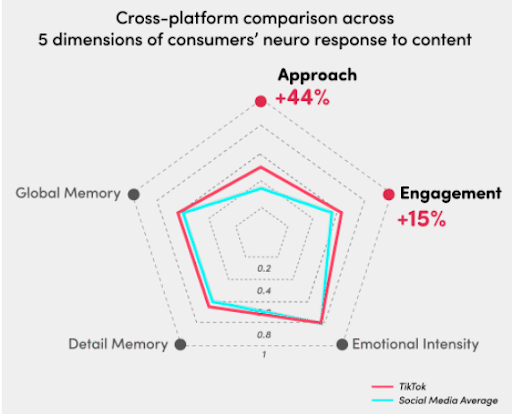
A Playground for Creativity
TikTok is a playground for creativity – it allows users to edit videos, use a wide range of filters and effects, add trending music, and so on. There are lots of opportunities for brands to be creative, experiment with video content, build meaningful connections with the audience, and expand their reach beyond existing fans.
Daily Trends
The best part about TikTok is that there are always new trends! TikTok trends open up a new way businesses communicate and connect with their customers, as images and boring text are transforming into engaging videos and conversations. Hopping on the latest trends, brands can become a part of the everyday moments and drive conversations on TikTok.
Who are TikTok users?
TikTok is a powerful platform for brands looking to expand their reach to young adults, as nearly 53 percent of TikTok global users were between 18 and 25 years old. Users aged 13 to 17 years were the second largest user group with approximately 19 percent. As of January 2022, 57 percent of TikTok’s global users were women.

As of June 2021, TikTok’s user base in Southeast Asia has exceeded 240 million, up by 85% year-on-year. Around 800 million videos were created by these users, reaching more than a trillion video views in June alone. According to a report, approximately 70 percent of TikTok users are Gen Zs, followed by users aged 26 to 32 years old. Male users made up slightly more than half of the users (52.4% and 47.6%, respectively).
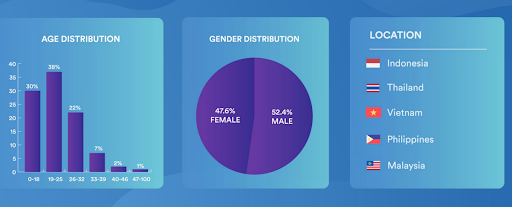
In early 2022, figures published in ByteDance’s advertising resources indicate that TikTok had 1.83 million users aged 18 and above in Singapore. It also indicated that TikTok’s ad reach in Singapore was equivalent to 33.5 percent of the local internet users, regardless of age. Female users made up slightly more than male users with 54 percent.
Is TikTok just for Gen Z?
This is what we often hear from businesses: “TikTok is just for Gen Z. My target audience is not Gen-Z”. If we take a look back on other platforms like Instagram and Facebook, they all started off as very new platforms with little value for businesses. The same is expected with TikTok. In fact, there are signs that TikTok is reaching a wider audience, with content not limited to dances and lip-synching videos. There are cooking, parenting, education, and science videos on TikTok, and they are growing in popularity.
What do people want to see on TikTok?
TikTok is well-known for its fun and entertaining content. According to Nielsen, TikTok was the only app where “lifting my spirits” was a top reason for using it. Additionally, nearly 3 out of every 4 users said that they felt inspired and entertained while using TikTok!
Below are some of the most popular content categories on TikTok, according to Statista:
- Entertainment
- Dance
- Fitness/Sport
- Beauty/skincare
- Fashion
- Cooking/recipes
- Lifehacks/advice
TikTok Trends and Challenges
TikTok is all about the trends. The platform is designed to showcase any trends at the moment, so spotting new trends on TikTok is not difficult. Once a trend starts to gain traction, jumping on it can help brands drive more traffic and increase their follower base.
Here are 4 easy ways for you to keep up with the current trends on TikTok:
- The “Discover” Tab: Scroll through popular sounds, hashtags, and topics along with a preview of the top videos within the category.
- The “For You” Page: This page offers never-ending ideas and trending videos. If a video has thousands of likes or views, it’s worth digging into as it might be related to a new trend.
- The “Search” Tab: TikTok’s search tab is another way to discover new trends. You can type in with your industry/product name, and TikTok will auto-populate suggested searches based on trending topics.
- The #TrendAlert2022 Hashtag: Some hashtags that TikTok creators have been using to detect (or create) new trends are #TrendAlert, #TrendingNow, #TrendAlert2022.
The TikTok challenge is another thing to keep an eye on, as it is one of the biggest trends on the platform. The idea of a challenge is simple: It is fun to get people’s attention and easy for them to participate. We will share more about it later.
Who are TikTok stars?
TikTok has created a whole new generation of social media influencers. They have the expertise to produce video content and the power to influence their followers. According to the Influencer Marketing Report by Affable, as of June 2021, 51 percent of TikTok influencers in Southeast Asia are between 19 and 25 years old. A majority have a following from 10k – 50k (47%), followed by influencers with 50k – 100k followers (25%).

In general, influencers having 10k – 100k followers have the highest engagement rate on TikTok. It is not surprising as micro-influencers are considered more authentic and develop a more personal relationship with their audience.


